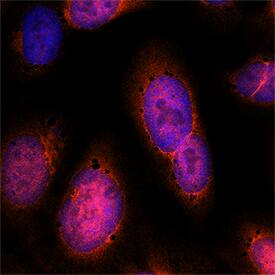Human TIGAR/C12orf5 Antibody
R&D Systems, part of Bio-Techne | Catalog # AF7629

Key Product Details
Species Reactivity
Applications
Label
Antibody Source
Product Specifications
Immunogen
Ala2-Arg270
Accession # Q9NQ88
Specificity
Clonality
Host
Isotype
Scientific Data Images for Human TIGAR/C12orf5 Antibody
Detection of Human TIGAR/C12orf5 by Western Blot.
Western blot shows lysates of HeLa human cervical epithelial carcinoma cell line, Jurkat human acute T cell leukemia cell line, and U2OS human osteosarcoma cell line. PVDF membrane was probed with 0.5 µg/mL of Sheep Anti-Human TIGAR/C12orf5 Antigen Affinity-purified Polyclonal Antibody (Catalog # AF7629) followed by HRP-conjugated Anti-Sheep IgG Secondary Antibody (Catalog # HAF016). A specific band was detected for TIGAR/C12orf5 at approximately 30 kDa (as indicated). This experiment was conducted under reducing conditions and using Immunoblot Buffer Group 1.TIGAR/C12orf5 in U2OS Human Cell Line.
TIGAR/C12orf5 was detected in immersion fixed U2OS human osteosarcoma cell line using Sheep Anti-Human TIGAR/C12orf5 Antigen Affinity-purified Polyclonal Antibody (Catalog # AF7629) at 5 µg/mL for 3 hours at room temperature. Cells were stained using the NorthernLights™ 557-conjugated Anti-Sheep IgG Secondary Antibody (red; Catalog # NL010) and counterstained with DAPI (blue). Specific staining was localized to cytoplasm and nuclei. View our protocol for Fluorescent ICC Staining of Cells on Coverslips.TIGAR/C12orf5 in Human Breast Cancer Tissue.
TIGAR/C12orf5 was detected in immersion fixed paraffin-embedded sections of human breast cancer tissue using Sheep Anti-Human TIGAR/C12orf5 Antigen Affinity-purified Polyclonal Antibody (Catalog # AF7629) at 1.7 µg/mL overnight at 4 °C. Tissue was stained using the Anti-Sheep HRP-DAB Cell & Tissue Staining Kit (brown; Catalog # CTS019) and counterstained with hematoxylin (blue). Specific staining was localized to cytoplasm and nuclei. View our protocol for Chromogenic IHC Staining of Paraffin-embedded Tissue Sections.Applications for Human TIGAR/C12orf5 Antibody
Immunocytochemistry
Sample: Immersion fixed U2OS human osteosarcoma cell line
Immunohistochemistry
Sample: Immersion fixed paraffin-embedded sections of human breast cancer tissue
Western Blot
Sample: HeLa human cervical epithelial carcinoma cell line, Jurkat human acute T cell leukemia cell line, and U2OS human osteosarcoma cell line
Formulation, Preparation, and Storage
Purification
Reconstitution
Formulation
Shipping
Stability & Storage
- 12 months from date of receipt, -20 to -70 °C as supplied.
- 1 month, 2 to 8 °C under sterile conditions after reconstitution.
- 6 months, -20 to -70 °C under sterile conditions after reconstitution.
Background: TIGAR/C12orf5
TIGAR (TP53-Inducible Glycolysis and Apoptosis Regulator; also C12orf5) is a 29-30 kDa member of the phosphoglycerate mutase family of molecules. TIGAR is likely widely expressed, and serves as a target of p53 activity. Cellular glucose is normally converted into Glu-6-P. This compound can either be converted into Fru‑6‑P for use in ATP production, or directed into the pentose phosphate to create NADPH. If Fru-6-P is formed, it can be acted upon by either PFK1 or PFK2. PFK1 creates Fru-1,6-P2, which is subsequently broken down into pyruvate for use in the Krebs cycle. PFK2 creates Fru-2,6-P2, which is not an energy source but a regulator that promotes the activity of PFK1. TIGAR dephosphorylates Fru-2,6-P2, creating Fru-6-P. This both inhibits PFK1 activity, and drives the system backwards, recreating Glu-6-P which enters the pentose phosphate shunt and generates NADPH. p53 induces TIGAR synthesis, with a resulting increase in NADPH. NADPH increases glutathione which neutralizes ROS, and blocks activation of caspase-2. The emphasis away from energy production also leads to the activation of other pathways that produce molecules involved in DNA repair. Human TIGAR is 270 amino acids (aa) in length. It contains one histidine phosphatase domain (aa 6‑90) plus two utilized phosphorylation sites. There is one potential alternative start site at Met60. Full-length human TIGAR shares 72% aa sequence identity with mouse TIGAR.
Long Name
Alternate Names
Gene Symbol
UniProt
Additional TIGAR/C12orf5 Products
Product Documents for Human TIGAR/C12orf5 Antibody
Product Specific Notices for Human TIGAR/C12orf5 Antibody
For research use only


